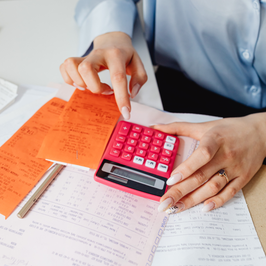Recession vs Depression: What's the Difference?

It's normal for the economy to go through ups and downs. Recessions and depressions both mark economic downturns, but they aren't exactly the same. Recessions are more common and represent significant declines in economic activity. A depression is an extreme recession that lasts longer and is accompanied by severe economic contraction. Neither are great for the economy, but no recession or depression has lasted forever.
What is a recession?
A recession is a significant economic decline that affects large portions of the economy, not just one or two sectors. During a recession, the unemployment rate typically rises while the country's gross domestic product and consumer spending both fall. Most experts would agree we're in recession territory when there's a significant drop in economic activity that goes beyond a few months.
What causes a recession?
Certain economic conditions can trigger a recession. Those conditions include:
-
An overheated economy: When the economy grows too quickly, manufacturers can’t keep up with high demand from consumers and businesses. Low interest rates can also contribute to tight supply. So prices increase, which can lead to inflation. The Federal Reserve may raise interest rates to try and drive down demand.
-
A financial bubble: Rapidly growing asset bubbles (such as a housing bubble) can cause a recession if they eventually pop. The bursting of the dot-com bubble in the early 2000s led to a subsequent recession.
-
An extreme situation that jolts the economy: The 2008 subprime mortgage crisis and the coronavirus pandemic both shook the economy hard. They each were followed by recessions.
Signs of a recession
A recession may be on its way when you notice these signs:
-
Falling GDP: A consistently shrinking GDP means consumer demand is dropping and there are fewer workers to produce goods and services. So it's one indicator a recession may be on the horizon.
-
Inflation: Businesses may react to higher costs by increasing prices and reducing production, which can signal an impending recession. A run-up in inflation doesn't necessarily mean a recession is underway. But it's worth noting that since World War II, inflation has come before all but two recessions.
-
High unemployment: Businesses may also respond to higher prices by reducing their workforce. There's been high unemployment before all but two recessions since the 1940s.
-
Severe stock market declines: The stock market dropped significantly following the dot-com bubble burst and the 2008 subprime mortgage crisis. Recessions followed both. To be clear, stock market declines are a normal part of investing and do not necessarily signal a recession. Even bear markets, which happen when market indexes fall by at least 20%, often go on to correct themselves.
What happens in a recession?
A recession can have far-reaching ripple effects. Those may include:
-
Higher prices: Everyday products such as gasoline, groceries, and clothing may cost more during a recession. Higher prices can impact your purchasing power and household budget. As a result, consumer spending generally declines.
-
Declines in manufacturing: Businesses typically cut back on manufacturing due to rising material costs. This can lead to a drop in economic activity.
-
Less job security: Layoffs can go hand in hand with a recession. In turn, the job market might become more competitive.
-
Wages stalling out: Your earnings may not rise as quickly during an economic slowdown. Employers may temporarily freeze pay or work bonuses.
How long do recessions last?
Now for a bright spot: Recessions don't last forever, and they're considered a natural part of the economic cycle. Since 1980, the United States has experienced six of them. The Great Recession lasted longer than any other. It began in December 2007 and didn't end until June 2009. The shortest one on record was the two-month recession brought on by the COVID-19 pandemic. From 1854 to 2020, the average recession lasted 17 months, according to the NBER.
How to prepare for a recession
The best time to prepare for a recession is when the economy is strong, but there's really no bad time to strengthen your financial health. Here are some simple ways to prepare your finances for a recession:
-
Pad your emergency fund. Building your cash reserves can help recession-proof your finances. If you experience a stint of unemployment or a temporary dip in income, your savings can help see you through. One rule of thumb is to set aside three to six months' worth of expenses in your emergency fund. Even a little cushion is better than nothing.
-
Get ahead of high-interest debt. The Federal Reserve tends to bump up interest rates to rein in inflation. That effectively increases the cost of borrowing money. The U.S. saw seven interest rate hikes in 2022 — and three more in the first two quarters of 2023. Paying down high-interest debt sooner rather than later could help you weather a recession.
-
Revisit your budget. Cutting your expenses is one way to free up money in your monthly budget. Look to things you could easily live without, like old subscription services you don't really use. Planning your meals, comparing new insurance policies and scaling back on discretionary spending can all help.
-
Advocate for your career. Consider sharpening your skills, nurturing your professional network, and advocating for your career. That may mean negotiating a raise or bonus, or job hunting before the economy slows down.
What is a depression?
There isn't a clear definition, but a depression is typically seen as an extreme recession that lasts longer and causes more damage. The Great Depression was the last time it happened in the U.S., and it was the most severe economic downturn in U.S. history. During a depression, economic activity may feel like it's coming to a halt. The effects can be devastating, but the upside is that depressions are much rarer than recessions.
What causes a depression?
A variety of factors can trigger a severe economic downturn. The Great Depression was caused by a mix of increasing consumer debt, a drop in consumer demand, and an industrial production slump. The rapidly expanding stock market didn't help matters. Experts now say stocks were overvalued and investors were overly confident. In October 1929, the stock market crashed, plunging 25% in a matter of days. People panicked, which led to a major selloff and a massive economic crisis.
Signs of a depression
A depression is a severe recession that isn't letting up. One may be on the horizon when unemployment is extremely high, assets are routinely devalued, and consumers are defaulting on debt. All of these factors were at play before the U.S. entered the Great Depression in late 1929. In August of that year, just before the market crashed, the unemployment rate was 0.04%. By October, it was over 2% and continued climbing. Dwindling consumer demand and subsequent manufacturing slowdowns also paved the way for the Great Depression.
What happens in a depression?
Depressions can ravage the economy. During the Great Depression, the real GDP fell by 30%, and the unemployment rate went on to surpass 25% by 1933. Close to a third of the U.S. banking system also failed in the early 1930s. Thousands of Americans lost their jobs, savings and homes. Just keep in mind that the Great Depression was a unique time in U.S. history. Modern-day recessions, even severe ones, don't necessarily indicate that a depression is on its way.
How long does a depression last?
While recessions are usually counted in months, a depression can last for years. The Great Depression lasted more than a decade. It began in 1929 and didn't end until 1941. This dark economic period is the only "depression" the U.S. has experienced.
How to prepare for a depression
Getting your financial house in order, to whatever degree that's possible, is probably the best protection. That includes scaling back on spending, prioritizing your emergency fund, and looking for ways to boost your income. You might also invest differently during economic slumps. Falling stock prices could be an opportunity to buy at a discount. Some strategies include:
-
Sticking to dollar-cost averaging: That means investing the same amount of money at regular intervals, regardless of what's happening in the market. Automated 401(k) contributions are a good example of dollar-cost averaging. You'll end up buying more assets when prices are low, and fewer when prices are high. It keeps you in the game and can help prevent emotional decision-making.
-
Looking into dividend-producing stocks: Some companies dole out dividend payments on top of regular earnings. That can allow you to continue earning money, even when the market is down.
-
Staying diversified: Diversification is always important, but especially during economic slowdowns. Dedicating too much of your portfolio to one asset class or economic sector could come back to bite you if things go south. Having a healthy mix of investments can help spread out risk and offset losses.
With Acorns, you can automate your investments. Staying invested, even during market downturns, can allow you to benefit from future recoveries.
Recession vs depression: The key differences
A depression is more severe than a recession
While a recession isn't exactly welcome news for the economy, it's less severe than a depression. It tends to run its course before eventually puttering out. And while recessions can be disruptive — the Great Recession is a prime example — they don't come anything close to the depression we saw in the 1930s.
Inflation is linked to recessions, not depressions
Rising prices tend to accompany recessions. But during the Great Depression, consumer prices declined dramatically. From 1929 to 1933, the consumer price index dropped by more than 27%. Deflation and low consumer spending became hallmarks of the tough economic times.
Recessions are a normal part of the economic cycle
Recessions often come about after periods of economic expansion. Like bear markets, they're seen as short-term economic slowdowns. A depression, on the other hand, is far less common. There's only been one depression over the last century.
Dollar Cost Averaging does not ensure a profit or protect against losses. It involves continuous investing regardless of fluctuating price levels.
This material has been presented for informational and educational purposes only. The views expressed in the articles above are generalized and may not be appropriate for all investors. The information contained in this article should not be construed as, and may not be used in connection with, an offer to sell, or a solicitation of an offer to buy or hold, an interest in any security or investment product. There is no guarantee that past performance will recur or result in a positive outcome. Carefully consider your financial situation, including investment objective, time horizon, risk tolerance, and fees prior to making any investment decisions. No level of diversification or asset allocation can ensure profits or guarantee against losses. Article contributors are not affiliated with Acorns Advisers, LLC. and do not provide investment advice to Acorns’ clients. Acorns is not engaged in rendering tax, legal or accounting advice. Please consult a qualified professional for this type of service.








